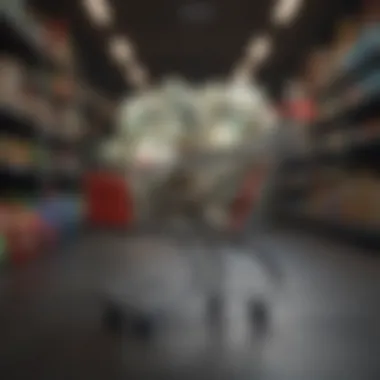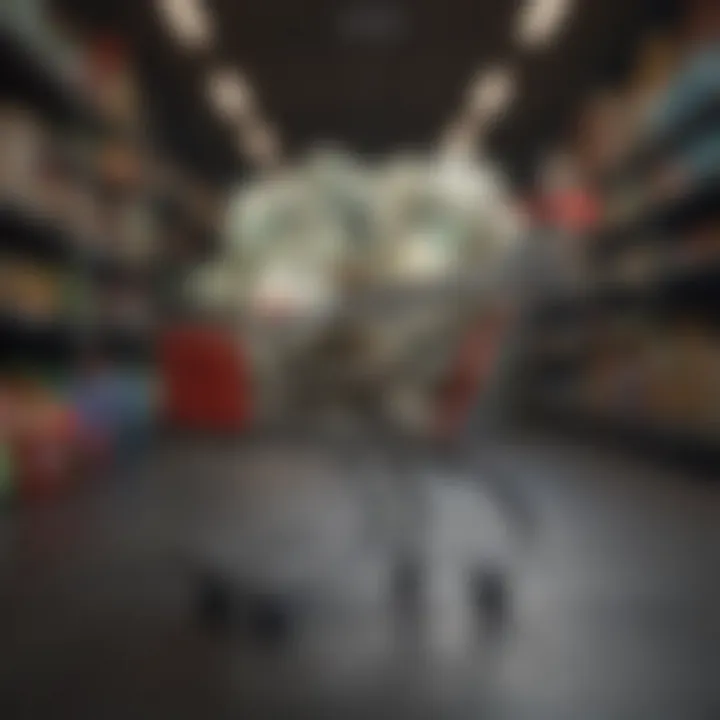Maximizing Savings with Grocery Rebate Apps


Intro
In a world where every penny counts, finding ways to save on everyday expenses becomes imperative. One of the latest trends in consumer savings is the rise of grocery rebate apps. These handy little tools have been designed not just to streamline the shopping experience, but to actually reward you for your purchases. A growing number of shoppers are turning to these apps, discovering that when they bring home groceries, they can also bring home some cash.
The concept is simple but effective: by scanning receipts or linking your purchasing habits, the app offers you a percentage back on what you've spent. This approach not only helps you maintain a tighter budget but also creates an incentive for smarter shopping habits.
What to Expect
In this article, we aim to explore the various facets of grocery rebate apps. We’ll delve into how these apps operate, the types of rewards they provide, and the overall impact they can have on your shopping behavior. We will also take a look at some of the most popular options available in the market, share user experiences, and offer practical advice on getting the most out of these platforms. So, if you're looking to stretch your dollar a bit further, keep reading!
Key Terms and Definitions
Before we dig into the specifics, it's important to establish some key terms associated with grocery rebate apps. Having a clear understanding of the terminology will help you navigate your choices more effectively.
Grocery Rebate Apps
These are mobile applications designed to offer users cash back or rewards for grocery purchases. Examples include Ibotta, Checkout 51, and Fetch Rewards. These apps often require users to upload receipts or link rewards cards to track purchases.
Cash Back
Cash back refers to the money returned to consumers after they make a purchase. In the context of grocery apps, this usually appears as a percentage of the total bill, which can be withdrawn or used for future purchases.
Receipt Scanning
Receipt scanning is a feature many rebate apps provide that allows users to take photos of their grocery receipts after purchase. The app processes the receipt and calculates the cash back based on eligible items.
"Savings might be small at first, but they add up to a larger amount over time, making grocery rebate apps a smart choice for savvy shoppers."
Shopping Habits
This term encapsulates the behaviors and patterns of consumers when purchasing groceries. Rebate apps can influence these habits by encouraging users to select specific brands or products to maximize their savings.
The Mechanics of Grocery Rebate Apps
Understanding how these apps work is critical for maximizing your savings. First, most apps operate on the same basic principle: earn rewards by purchasing qualifying items. After you've shopped, you'll either scan your receipt or link your store loyalty card for the app to track your purchases. The more regularly you use the app, the more savings you can accumulate.
Additionally, many of these apps have partnerships with grocery stores and brands, meaning users might find exclusive offers that aren't available elsewhere. Be mindful, however, as not every item may qualify for cash back. It often pays to check the app prior to finalizing your shopping list.
Types of Rewards Offered
- Cash Back: A straightforward refund of a percentage of your total grocery spend.
- Gift Cards: Some apps allow you to redeem your earnings for gift cards to popular retailers, which many find to be a appealing option.
- Bonus Offers: Limited-time promotions or bonuses can provide extra savings on specific brands or purchase amounts.
As we explore user experiences and popular apps further, these elements will become clear and help in making informed decisions about which app might best suit your needs.
Understanding Grocery Rebate Applications
Grocery rebate applications are more than just a passing trend in the world of consumer savings. They represent a transformative shift in how people approach grocery shopping. In today’s fast-paced life, where every penny counts, these apps are tantamount to having a financial ally right in your pocket. They empower consumers by offering incentives that can significantly alleviate the burden of monthly grocery expenses. Understanding how these applications work and their associated benefits is essential for those looking to make the most of their shopping experience.
Definition and Functionality
Grocery rebate apps are platforms that reward users with cash back or equivalent gains for purchasing specific grocery items. Typically, users browse available deals within the app before heading to the store or, in some cases, scan their receipts after shopping.
Some apps require you to select offers ahead of time, while others operate on a broader spectrum, allowing you to earn rewards on almost anything you purchase. This flexibility in usage is a big draw for buyers, not to mention the simplicity of the process—just snap a photo of your receipt, and voila! Funds start adding up either in the form of cash back or points.
Key functionalities include:
- Real-time deal notifications: Users can get updates on limited-time offers for their favorite brands.
- Personalized recommendations: Some platforms utilize algorithms to suggest deals based on past buying behaviors.
- Easy withdrawal options: Many apps offer straightforward methods for cashing out, whether through direct deposit or gift cards.
Historical Context
The roots of grocery rebate applications can be traced back several decades when coupon clipping was all the rage. While physical coupons served their purpose, they required significant effort—cutting them out of newspapers, remembering to bring them to the store, and sometimes forgetting to use them altogether. As the digital age began to burgeon, more efficient methods became necessary to attract cost-conscious consumers.
Fast forward to the early 2010s, when smartphone technology exploded, and companies recognized the potential of mobile applications. The introduction of apps like Ibotta and Rakuten marked the beginning of a new chapter in shopping behavior. They offered convenience and immediacy that traditional coupons could not compete with. Consumers began shifting their habits, preferring to scroll through apps over riffling through piles of papers. This shift wasn’t merely a convenience but rather a significant cultural change in how individuals grasped their spending.
Today, grocery rebate applications signify a conscious effort by retailers to nurture customer loyalty while simultaneously giving buyers a sense of control over their finances. These apps now form an integral part of the shopping landscape, revealing a convergence of technology, consumer psychology, and marketing strategies that reveals much about the modern economy.


The Economic Rationale Behind Grocery Rebates
Understanding the economic rationale behind grocery rebates is essential for grasping how these applications impact both consumers and retailers. At its core, the rationale illustrates the intricate relationship between consumer behavior and pricing strategies. For consumers, these apps present an opportunity not just to save money, but also to engage in a more savvy shopping experience. Moreover, they encourage mindful spending, transforming grocery shopping from a mere task into a strategically optimized process.
Consumer Behavior Insights
When it comes to consumer behavior, it's fascinating to observe how these rebate apps reshape shopping habits. Research indicates that the presence of a rebate significantly sways decision-making. People tend to gravitate towards brands and products that promise financial incentives, even if they might not be the usual favorites. This shift can be attributed to a basic principle of behavioral economics: the perceived value of getting something back effectively increases the attractiveness of a product.
For instance, consider a family deciding between two similar brands of cereal. If Brand A offers a cash rebate via an app while Brand B does not, it’s likely that Brand A will win out, regardless of taste or quality. This phenomenon—termed anchoring—shows that the rebate influences consumer perception of value.
Additionally, consumers start incorporating more technology into their buying habits. According to surveys, users who engage with rebate apps tend to check prices more frequently, compare options, and actively seek deals. Some even establish a disciplined approach to grocery shopping, which leads to more carefully curated shopping lists. This behavior not only benefits individual finances but also contributes to a more thoughtful consumption pattern.
Impact on Retail Pricing Strategies
The advent of grocery rebate apps has prompted retailers to rethink their pricing strategies significantly. Retailers realize that offering rebates is not merely a promotional gimmick; it’s an integral part of maintaining competitiveness in a densely populated market. By collaborating with rebate applications, they can lure back foot traffic that may have shifted to competitors. This strategy allows them to utilize inducements in innovative ways.
When retailers understand user behavior, they can strategically set prices that attract consumers while still retaining profit margins. For instance, a seller might keep regular prices high while offering promotional rebates, which can create an illusion of savings while buffering the margin on frequently purchased items. Moreover, real-time feedback from rebate platforms provides retailers with invaluable insight into consumer preferences and spending patterns. This information can inform inventory management, marketing strategies, and even product placements in-store, creating a streamlined shopping experience.
Ultimately, the economic dynamics surrounding grocery rebate apps benefit all parties involved. Consumers enjoy immediate rewards for their spending, while retailers gain insights and foot traffic that can translate into increased sales. As long as this system remains transparent and user-friendly, there's every reason to believe that grocery rebate apps will continue to be a staple of modern consumer behavior.
Types of Rewards Offered
Understanding the types of rewards offered by grocery rebate apps is essential for consumers looking to maximize their savings. The variety and structure of these rewards can significantly influence not only how much money you can save but also how effectively you engage with these applications on a regular basis. In this section, we will delve into two primary categories: cash back systems and points systems, as well as promotions and special offers.
Cash Back vs. Points Systems
When it comes to grocery rebate apps, the most common reward structures are cash back and points systems. Cash back rewards are straightforward: for every dollar you spend on groceries through an app, a certain percentage (typically between 1% and 10%) is returned directly to you. This model appeals to those who prefer instant gratification – after all, getting cash in hand can feel particularly rewarding and allows you to apply the savings immediately or save them for a rainy day.
Example: If you spend $100 on groceries and your cash back rate is 5%, you will earn $5 back.
This approach often resonates with consumers who prioritize immediacy in their rewards systems.
On the flip side, we have points systems. Here, users earn points for each purchase, which can later be redeemed for discounts, gift cards, or even other products. The conversion of points to actual monetary value may vary, meaning that sometimes, this seems a bit like a game of chance.
For instance, you might earn 100 points for every $10 spent, but you might need 1,000 points to get a $5 gift card.
This adds an element of complexity and can lead to confusion about the true value of the rewards.
Ultimately, the choice between cash back and points often boils down to personal preference. If you like to keep things simple, cash back may be the way to go. If you enjoy a bit of strategy and perhaps are more incentivized by potential future rewards, then a points-based system might interest you.
Promotions and Special Offers
Another vital aspect of grocery rebate apps is the promotions and special offers they roll out. These can significantly sweeten the deal, allowing users to save even more money on their grocery bills. Often, these promotions can be seasonal, tied to particular products, or partnered with specific brands.
For example, a rebate app might offer double cash back on all produce purchases during the month of June to encourage healthier eating habits.
Or perhaps an app partners with a well-known brand to provide exclusive discounts on their products for a limited time. This kind of strategy not only boosts customer engagement but also helps users make the most of their grocery shopping experience.
It’s also worth mentioning the importance of timing and awareness in capitalizing on these promotions. Many rebate apps highlight current offers prominently on their home page or through notifications. Therefore, keeping up to date with the latest deals can maximize your savings potential.
Understanding what’s available at any given time means you’re never leaving money on the table!
Consider signing up for push notifications from your favorite apps to stay informed about new promotions as they arise.
Finale
In summary, whether you prefer straightforward cash back rewards or opt for the potentially more rewarding points systems, understanding the types of rewards offered by grocery rebate apps can lead to better financial decisions. Furthermore, staying alert to promotions and special offers can amplify your savings exponentially. Prioritizing these elements will help you navigate the grocery rebate landscape, ensuring that you are making the most out of your spending.
Prominent Grocery Rebate Apps
In today's digital world, grocery rebate apps stand as a testament to how technology can streamline financial wellness. These applications allow consumers to save money while purchasing daily essentials, thus transforming our routine grocery shopping into an opportunity for savings. The importance of these apps lies not just in the rebates they offer but also in the nuances of their operation, the variety of rewards, and the immense utility they provide to users. Recognizing the significance of prominent grocery rebate apps offers insights into maximizing savings and making informed decisions about expenses.
Overview of Popular Platforms
When it comes to savings on groceries, several grocery rebate apps have garnered attention in the market. Platforms like Ibotta, Rakuten, and Fetch Rewards have become household names among savvy shoppers. Each of these apps brings unique traits to the table, appealing to diverse consumer needs.
Ibotta, for instance, has a user-friendly interface paired with a wide array of participating retailers. This app allows users to claim cash back on purchased items simply by uploading their receipts, making it a seamless experience. Meanwhile, Rakuten offers an overall cash-back approach that extends beyond groceries, engaging users through a robust online shopping platform. Lastly, Fetch Rewards focuses on scanning receipts to earn points that can be redeemed for gift cards, providing users with flexibility when it comes to saving.
One of the striking aspects of these apps is how they've fostered a community element. Users can often share their experiences on forums like Reddit, creating a wealth of knowledge that new users can tap into, thus enhancing the overall value of these platforms.
Comparative Analysis of Features
In comparing these grocery rebate apps, several key features emerge that define their usability and effectiveness.
Usability


Usability plays a pivotal role in how users engage with these apps. Ibotta’s straightforward approach allows consumers to easily navigate the app and find eligible offers. The clean layout contributes to a pleasant user experience, making it a popular choice for both tech-savvy individuals and those less familiar with apps. This ease of use is complemented by the app's well-structured categories, enabling shoppers to quickly locate deals that align with their grocery needs.
However, not all applications excel in usability. Some users have reported challenges in understanding the redemption process on Rakuten, particularly due to its cash-back model which can be perceived as less direct than immediate savings methods.
Rewards Structure
The rewards structure is another essential attribute to explore. Fetch Rewards employs a unique system where points accumulate through receipt scanning, which can be appealing for those who may forget to redeem offers regularly. It provides a straightforward way to rack up points without needing to remember specific deals. In contrast, Ibotta leverages a more traditional model where users select relevant offers before shopping. This can offer deeper savings but requires an extra step in planning before the trip to the grocery store.
The varying rewards structures can influence user satisfaction. While some consumers appreciate the immediacy of Fetch Rewards, others find a sense of achievement in planning their Ibotta deals ahead of time.
Customer Support
Consideration of customer support services is vital for a positive user experience. Established apps, like Ibotta, generally have robust customer support systems in place, offering assistance through various channels, including email and live chat options. This ensures that users can quickly resolve issues, enhancing overall satisfaction. Notably, Rakuten has faced feedback regarding slower response times, which can be frustrating for users needing immediate help.
A unique feature of customer support on Fetch Rewards is their community support via social media, where users can share tips and express concerns, creating a support system outside of traditional customer service channels.
To summarize, the landscape of prominent grocery rebate apps reveals a mix of usability, rewards potential, and customer service quality, all of which contribute to the overall app experience. Identifying these elements can guide users toward selecting the app that best suits their saving needs, ensuring effective grocery shopping habits that contribute to healthier financial outcomes.
User Experience and Satisfaction
In the world of grocery rebate apps, user experience and satisfaction play a pivotal role. The ease of navigation, the design of the app, and the overall functionality can significantly determine how users perceive the app's value. When consumers find an app intuitive and user-friendly, they're more likely to engage with it consistently. A seamless experience promotes retention, leading to more frequent usage and ultimately, greater savings. Users are not just looking for financial benefits; they seek an enjoyable experience that complements their shopping routine.
Moreover, effective customer support and responsiveness to user feedback can enhance satisfaction levels. Users who feel their concerns are addressed promptly tend to be more loyal. Satisfied users often become brand advocates, sharing recommendations with friends and family, amplifying the app's reach without extra marketing costs.
User Testimonials
User testimonials are a gold mine of information, showcasing real-world experiences and giving potential users insights into the app’s reliability. Hearing stories from everyday shoppers can break the monotony of marketing jargon, making the apps feel relatable. For instance, one shopper claimed that using Ibotta helped her save nearly $200 monthly, allowing her to indulge in a few extra treats for her family each month. Another user shared how Fetch Rewards turned his grocery shopping into a game, collecting points that built up over time, making every visit to the supermarket an opportunity for savings.
However, testimonials must be taken with a grain of salt. Consumers should do their research, as experiences can vary widely based on location and individual usage.
"I thought these apps were just gimmicks until I tried them. Now, they are part of my grocery strategy!
Challenges Users Face
Despite the benefits, users often encounter challenges when using grocery rebate apps. One common issue is the time commitment. Many apps require photo validation or manual input of receipts, which can be tedious, particularly for those juggling busy schedules. Users may feel encouraged to save money but can become frustrated when the process becomes a chore.
Another challenge is the limited redemption options. Some apps may emphasize certain stores, restricting users from gaining rewards at their preferred grocery chains. This limitation can lead to dissatisfaction, especially if users are loyal to a particular retailer. Many might find it disheartening when the app they’re invested in doesn’t align with their shopping habits.
Lastly, data privacy concerns are becoming increasingly prevalent. Users often worry about how their personal information may be used or shared. Thus, transparency from apps about their data collection practices is crucial in maintaining user trust. The balance between the convenience of savings and the protection of personal data often places consumers in a precarious position.
Maximizing Benefits from Grocery Apps
Grocery rebate apps have transformed the way people shop for essentials. Instead of simply pushing carts and swiping credit cards, users can now get tangible rewards for their purchases. The significance of maximizing benefits from these apps can’t be overstated. Not only do they offer a way to recover some of the costs associated with grocery shopping, but they also promote smarter spending habits. Understanding how to fully leverage these applications can be a game changer for anyone looking to stretch their dollars further.
Strategies for Effective Use
To make the most out of grocery rebate apps, you need a clear strategy. Here are some essential methods:
- Plan Your Shopping: Create a grocery list based on current promotions available in your app. This ensures you're not just buying items for the sake of rewards.
- Stack Offers: Many apps allow users to combine deals. A product might have a supermarket sale, a manufacturer rebate, and an app offer all at once. By stacking these offers, you can significantly increase your savings.
- Stay Updated: The world of grocery apps is ever-changing. New offers pop up frequently. Regularly check your app for updates or subscribe to notifications where possible.
- Participate in Surveys or Activities: Some rebate apps offer additional incentives for completing surveys or games. This is an easy way to earn extra points or cash back.
- Use Social Media for Insights: Platforms like Reddit and Facebook often have groups where users share tips, hacks, and which items are yielding the best rebates. Engage with those communities for fresh strategies.
By implementing these strategies, users can not only save a few bucks but could end up maximizing their overall grocery budget.
Combining Apps for Enhanced Savings
The realm of grocery rebate apps is not a one-size-fits-all situation. In fact, enjoying multiple apps simultaniously can lead to enhanced savings. Here’s how combining can work:
- Diversify Your App Portfolio: Using different grocery rebate apps lets you tap into various offers and promotions. For instance, if you find a cashback deal on Ibotta but have another discount on Checkout 51 for the same product, using both can amplify your savings.
- Check Compatibility: Some apps are designed to work with others. For example, certain offers on Shopper’s Guide may be stackable with others found on Rakuten. Make sure to read the fine print regarding compatibility.
- Monitor Expiry Dates: Each app may have its own offer duration. Keep track of these dates to ensure you don't miss out on any savings minutes before they expire.
- Know Your Market: Different apps can provide insights on various stores as prices fluctuate. You can often find different rebates or discounts by simply checking which app benefits you in a specific retailer.
By combining multiple grocery rebate applications, users effectively create a synergistic effect that multiplies overall savings, leading to better budgeting and reduced grocery costs.
“Maximizing benefits from grocery rebate apps requires diligence, awareness, and a strategic approach to shopping.”
With the right strategies and a willingness to explore multiple platforms, navigating this landscape can lead to surprising returns on your grocery expenditures.
Privacy and Data Security Considerations


As individuals navigate the modern landscape of grocery shopping and digital rebate applications, the issues of privacy and data security rapidly come to the forefront. The integration of technology into daily spending habits invites numerous questions: How much personal data does one sacrifice for that enticing cash back? What steps are taken by these apps to safeguard sensitive information? This section aims to peel back the layers surrounding these pivotal considerations, ensuring users remain informed without feeling overwhelmed.
Data Collection Practices
Grocery rebate apps typically employ various data collection practices to enhance user experience while also tailoring offers and rewards. These practices can broadly be categorized into a few distinct areas:
- User Profiles: Most apps require users to register, gathering basic information such as names, email addresses, and payment details. Such information is often leveraged to create personalized offers.
- Transaction Tracking: By linking a credit or debit card, these applications are able to track purchases. This, in turn, facilitates the issuance of rebates on qualifying grocery items while also providing the app with rich data on consumer buying habits.
- Location Services: Some apps utilize geographic data to refine offers based on the user’s location. For instance, promotions might be tailored to stores nearby or regional favorites.
While access to such data can lead to enhanced rewards, one must be cautious. Users must actively consider the implications of sharing their data. This can include assessing whether the rewards justify potential privacy trade-offs.
User Awareness and Consent
In an era where personal data is often viewed as currency, awareness and consent become paramount. Users should approach grocery rebate apps with a discerning eye regarding how their data is managed. Here are some key aspects to consider:
- Review Policies: Before signing up, take the time to read privacy policies. They outline how your information will be used, stored, and, importantly, whether it could be shared with third parties.
- Opt-in Features: Many apps offer optional features requiring user confirmation, such as allowing targeted advertising or sharing data with partners. Recognize when you're being prompted to consent to additional data use.
- Regularly Update Preferences: Most apps allow users to change their privacy settings. Regularly updating these can give control over what data is shared.
Just as importantly, consumers should stay educated about the broader implications of their choices. Active participation in understanding how their data is handled empowers users, allowing them to make informed decisions.
"The price of freedom is eternal vigilance.” – Thomas Jefferson
In essence, privacy and data security are not just technical concerns; they should form a core part of any user’s strategy when engaging with grocery rebate applications. With awareness and consent firmly in place, users can enjoy the rewards associated with grocery apps while safeguarding their personal information.
Future Trends in Grocery Rebate Apps
As consumers increasingly seek to stretch their dollar further and optimize their shopping experiences, grocery rebate apps are evolving rapidly. Understanding the future trends of these applications is not only pivotal for consumers but also for industry stakeholders aiming to navigate this changing landscape. This section dives into transformative technologies and potential regulatory shifts that can redefine how these apps function and what they offer users.
Emerging Technologies
The pace of technological advancement is relentless. In grocery rebate apps, we see several innovations beginning to shape user experiences and business functionalities.
- Artificial Intelligence: AI is starting to play a significant role in personalizing user experiences. With AI, apps can analyze users' shopping habits and preferences, making tailored offers that resonate more with what individuals typically buy. This pushes users to engage more, maximizing their rebate potential.
- Blockchain Technology: As more consumers become conscious of data privacy, blockchain offers a transparent way to handle transactions. It can ensure that user data is secure and that the rebates are processed without the risk of tampering. The traceable nature of blockchain might also enhance trust between users and retailers.
- Mobile Payment Integration: With digital wallets becoming more mainstream, integrating grocery rebate apps with mobile payment solutions provides convenience. Shoppers can earn rewards in real-time during the checkout, streamlining what can sometimes be a tedious process.
"The future of grocery rebate apps isn't just about saving money—it's about making the whole shopping experience seamless and tailored to the individual."
These technologies promise not only to enhance how users interact with these apps but also to maintain user interest and loyalty over the long haul. The competition among apps based on technology could lead to a cycle of constant improvement—benefiting consumers significantly.
Potential Regulatory Changes
As grocery rebate apps proliferate, so too does the likely scrutiny of their business practices. Regulatory bodies may step in to ensure that these apps operate fairly and transparently, especially given the broad data collection often associated with them.
- Increased Data Protection Laws: With growing concerns about user privacy, regulatory changes akin to the European Union’s General Data Protection Regulation (GDPR) may be set to influence how apps gather and store user data in the U.S. This could lead to stricter guidelines on user consent and data usage, impacting how companies design their applications.
- Transparency Requirements: Future regulations might mandate greater transparency in how rebate algorithms work, allowing users clearer insight into how their personal data is being used to tailor offers. This can help dispel fears of manipulative marketing practices, ensuring that users feel secure in engaging with these platforms.
- Fair Competition Standards: As the market for grocery rebate apps grows crowded, there could be discussions around fair-trade practices and anti-monopoly regulations, aimed at preventing any one app from dominating the market. This encourages innovation and diverse offerings, ultimately benefiting consumers.
Understanding these potential changes not only prepares users for what to expect but also empowers them to advocate for a transparent and user-friendly landscape in the grocery rebate sector. By keeping an eye on emerging technologies and regulatory shifts, consumers can make informed choices about which apps best suit their needs.
As the landscape of grocery rebate apps continues shifting, consumers stay ahead of the curve by staying informed of these trends. The sum of these changes paints a promising future for those who actively engage in the process of saving.
Finale and Final Thoughts
The significance of this discussion on grocery rebate apps cannot be overstated. In an era where every penny counts, leveraging technology to bolster savings has transformed from a mere trend to a necessity. Grocery rebate applications not only help lighten the financial load of our shopping bills, but they also invite us to rethink our spending habits altogether. By offering rebates, these apps serve a dual purpose: they empower consumers to make informed purchasing decisions while supporting a broader pattern of budgeting and financial awareness.
Several elements contribute to the importance of grocery rebate applications. Firstly, the interaction of various platforms—each providing unique rewards and features—means consumers can tailor their savings strategies based on their individual needs. This diversity encourages healthy competition among these applications, driving them to enhance offerings and create better experiences for users.
Moreover, the insights gleaned from using these apps extend beyond simple cash back. Users often develop a more nuanced understanding of their own spending habits, helping to hone their budgeting skills. In essence, these apps can shift one's mindset from passive spending to active management of grocery expenditures.
"The best way to predict your future is to create it."
– Peter Drucker
At the same time, one must consider potential drawbacks, such as privacy concerns and the need for discernment regarding what constitutes a worthwhile offer. With the rise of such platforms, consumers must remain vigilant, ensuring they are not just pawns in a marketing game.
Recap of Key Insights
In this exploration of grocery rebate apps, several key points emerged:
- Understanding Functionality: Grocery rebate apps serve as tools designed to offer users returns on their purchases, contributing to overall savings.
- Consumer Behavior: These apps shape spending patterns, as users become aware of their grocery habits and rewards systems.
- Types of Rewards: Not all apps are the same; the divergence in rewards—ranging from cash back to points systems—means there's something for everyone.
- User Experiences: While most users appreciate the benefits of these apps, some challenges persist in navigating offers and understanding terms and conditions.
- Future Trends: Continuing advancements in technology and potential regulations will likely reshape the landscape of rebate applications in the coming years.
These insights highlight not only the potential for savings but also the need for a critical approach towards using these apps effectively.
Closing Remarks on Saving Strategies
Navigating the maze of grocery shopping and saving requires a unique blend of tech-savvy and common sense. Here are a few strategies that can optimize your experience with grocery rebate apps:
- Prioritize Your Needs: Choose apps that align with your regular purchases to maximize benefits. If you frequently buy organic produce, use apps that cater specifically to those items.
- Stay Informed: Keep an eye on promotions and limited-time offers, as these can provide extra savings when used strategically.
- Combine Resources: Don't hesitate to use multiple apps simultaneously to stack rewards, but do so judiciously to avoid getting overwhelmed.
- Regular Reviews: Check in periodically on your grocery spending. Adjust your approach based on what's working and what isn't, revisiting apps that provide the most effective savings.
- Engage with Community: Join forums or discussion groups on platforms like Reddit to share experiences and learn from others.
By employing these tactics, users can enhance their savings journey while enjoying the benefits of modern grocery shopping. Remember, every little bit saved adds up, contributing to your overall financial health.







